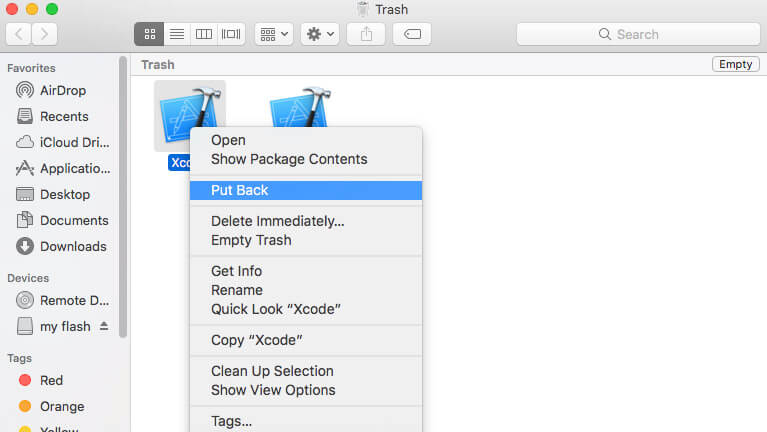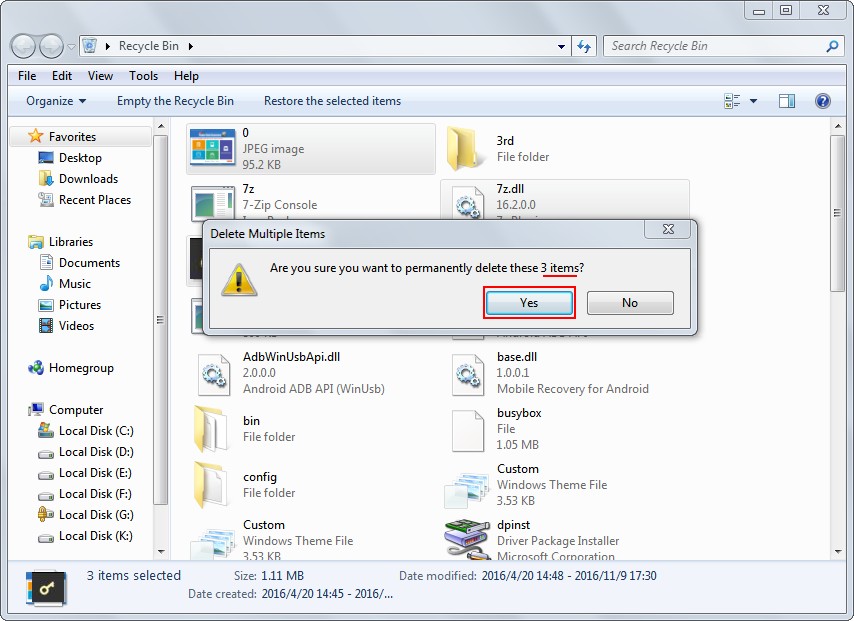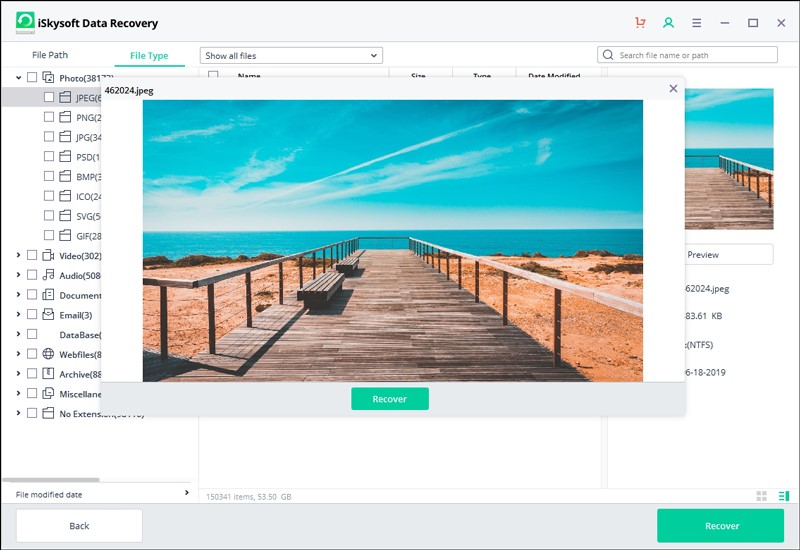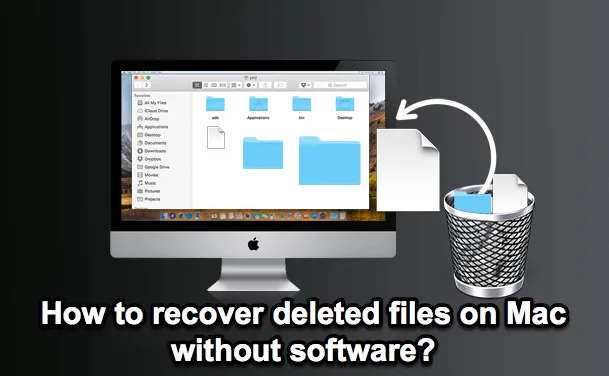- Free Way To Recover Deleted Files Mac Keyboard
- Free Way To Recover Deleted Files Mac
- Mac Restore Deleted Files
- Pandora Recovery Mac
- Free Way To Recover Deleted Files Mac External Hard Drive
- Undelete Mac Files
- Free Way To Recover Deleted Files Mac Os
There are two ways for you to recover deleted files on Mac for free without using data recovery software. One way is to undelete files from your Mac Trash bin. When you mistakenly deleted files on Mac computer to the trash, and you didn't empty the trash, you can undelete them from your Trash for free. Launch Disk Drill app on PC/Mac. Download Disk Drill data recovery software on computer. The free data recovery space up to 100MB. And for Mac users, installing Disk Drill software need to be dragged into 'Application' folder. Launch the data recovery software to prepare to recover overwritten files.
So you hit the “Empty Trash” option on your MacBook Pro, only to find that you had several important files got removed as well?

Or they are lost after you updated your machine to latest macOS Big Sur?
Those files could be the precious photos you’ve just synced from an iPhone/iPad, or some documents you’ve been working on for days…whatever they are, the question is – is it possible to recover files deleted from Mac Trash?
Quick answer: yes, though the chance is NOT a guaranteed 100%.
In this post, we’re going to explain the reasons why and show you the right step-by-step guide on how to recover those trashed files the best you can.
Contents
- How to Recover Trashed Files on Mac?
Are files deleted from Mac Trash still recoverable?
We all know that once you delete a file by dragging it to the Trash bin, it’s easy to undelete it. Simply go to the Trash, find the file, highlight it, right-click and select “Put Back”. Then you’ll find it immediately in its original location. You see, macOS doesn’t actually delete the file immediately.
But what if you also removed the file from the Trash? Does that mean it is gone for good?
Well, it depends.
If you are using a MacBook with a hard disk drive (HDD), the chance to recover the file is high.
Technically speaking, only the name of the file is removed from the disk directory of your Macintosh HD, and space the file originally takes is now marked as vacant, to be written over by new files generated by the user (you) or the system.
The disk directory we talk about here acts like a “chief-commander” to manage all the data writing activities that occur in a hard drive. It records everything, where every file lives, its size, etc. When you delete a file, only the “header” information of the file is removed while the real data remains intact.
So, as long as you don’t write anything new to the disk space, the file is usually recoverable. However, there is no way to tell when the released space will be reused.
If you are using a MacBook Pro with a solid-state drive (SSD), sadly it’s another story. When you erase the file, it’s usually beyond recovery unless you have a backup.
This is due to how the “Trim command” organizes a file in an SSD. When you delete a file from Trash, the TRIM system in Apple macOS also zeros out the actual data as part of its disk management, making the chances of salvaging the data slim.
Enough techy stuff, hope you get it 🙂 let’s move on.
How to Recover Trashed Files on Mac?
First things first — it is highly recommended that you stop using your Mac immediately. If your Mac has an HDD, try your best not to save or generate new files as they can possibly “over-write” the disk space. If your deleted files got overwritten, it’s extremely hard to retrieve them.
Step 1: Check if you have saved the files on another storage device.
Close your eyes for a few seconds, think about when you created the files.
For example, if they are photos, maybe they are still on your smartphone or on removable media (memory card, USB stick, external hard drive, etc.). Don’t forget the cloud storage services you might be using too.
Also, if they are project-based documents, maybe you’ve shared them with your co-workers, also check your email sent box to see if they are there.
Step 2: Restore from Time Machine backup.
If you have enabled Time Machine backup, you are in luck.
The files you trashed are probably in a previous Time Machine snapshot. Simply enter Time Machine and navigate to the folder where your erased items lie. This Apple support article is a detailed tutorial. If you prefer video tutorials, here’s a good one:
Step 3: Use a third-party Mac data recovery program.
If the above steps didn’t work out, your last option is to use a professional data recovery app.
We recommend Stellar Mac Data Recovery. The trial version is free and allows you to see if it is able to scan and locate the deleted files (with “Preview” functionality), you’ll need to purchase the software to fully recover the items though.
Other good alternatives include DiskWarrior 5 and Remo Recover Mac, in case Stellar doesn’t work for you.
Final words: backup is king!
In the digital age, your data is irreplaceable. The best way to avoid data disaster on Mac is to make good backups, or backup of backups 🙂
Apple Time Capsule is my first recommendation as it’s made by Apple. If you’re looking for something more affordable, check our our list of the best external drives for MacBook Pro.
Meanwhile, it’s worth noting that online backup services like Dropbox, iCloud, and Google Drive are also great choices, and they have free plans to get started.
Personally, I prefer hardware storage devices because they are more reliable and secure than online storage services. But hey, it’s up to you 🙂
We’ve all experienced that horrible stomach-churning pang of dread when we delete a file that we didn’t mean to delete. Or when we realise that the file we trashed last week is the one we need for an important piece of work that’s due to be submitted tomorrow. The bad news is that there’s no Mac undelete feature. The good news is that, most of the time, and depending on what steps you’ve taken beforehand, it’s relatively easy to recover deleted files on Mac.
Get Disk Drill on Setapp, a Mac tool that brings every deleted file back — instantly. Whatever the reason of data loss, you’ll rescue it all in few minutes.
Download Disk Drill FreeCheck if the file has really been deleted
The first step is to check if the file is gone. If you dragged it to the Trash but haven’t emptied it recently, it should still be there. Click on the Trash icon in the Dock and inspect the Finder window that opens. If you see the file, drag it out of the Trash and onto the Desktop. If the file isn’t there, things get more complicated, but there’s still hope.
How to recover deleted files on a Mac with Time Machine
This is the part where we remind you that you should have a regular incremental backup plan in place. Preferably, it should incorporate two separate backups to two different destinations, in different physical locations.
Free Way To Recover Deleted Files Mac Keyboard
If you use a tool that makes a bootable clone, such as Carbon Copy Cloner or SuperDuper, and regularly update the clone, all you have to do to recover a file is mount the clone and copy the file back to your Mac. If you take away nothing else from this article, please understand the importance of backing up your Mac on a regular basis. Your future self will thank you for it.
The simplest way to backup files on a Mac is to use Apple’s Time Machine, which is installed as part of macOS. You set it up once and forget it. Assuming you use Time Machine, it’s very easy to recover individual files. Here’s how:
1. Go to the Time Machine menu in the Mac’s menu bar and choose Enter Time Machine.
2. Swipe upwards with two fingers on your Mac’s trackpad or press the up arrow next to the Finder window that appears in order to navigate to a time before you deleted the file.
3. Once you’ve reached a backup from a time before you trashed the file, click on the Finder window and navigate the Finder in the normal way until you find the file you want to recover.
4. Press the spacebar to preview the file, and if it’s the one you want, click Restore. The file will now be restored to your current Finder and you’ll be able to open and edit it.
How to recover deleted photos on Mac
When you delete a photo in the Photos app, it doesn’t get rid of it straight away. Instead, it outs in an album called Recently Deleted and keeps it there for 30 days. Then it’s removed permanently. So, if the photo you want to recover was deleted less than 30 days ago, all you have to do is go to Recently Deleted, under Library in Photos’ sidebar, click on the photo you’re looking for and press Recover. It will then be moved back to your main Library.
Free Way To Recover Deleted Files Mac
How to recover music files in iTunes
If you delete a track from iTunes, it asks you if you want to move the file to the Trash. If you said no, all you have to do to recover the file is go to the Finder and navigate to your iTunes music folder (usually in Music>iTunes>iTunes Media), find the file and drag it onto the iTunes icon in the Dock.
If you said yes, and the file is still in the Trash, do the following.
1. Launch iTunes and choose Preferences from the iTunes menu.

2. Click the Advanced tab.
3. Makes sure there’s a checkmark in the box labelled 'Copy files to iTunes Media folder when adding to library’.
4. Close Preferences.
5. Drag the file from the Trash onto the Desktop.
Mac Restore Deleted Files
6. Drag it onto iTunes’ icon in the Dock.
7. When it’s imported, drag the file from the Desktop back to the Trash (a copy will have been added to your iTunes folder).
If you’ve emptied the Trash since you deleted the file from iTunes, you can use Time Machine to find it in the earlier version of your iTunes folder and recover it from there.
File recovery on Mac: How restore older versions of a document
Built in apps on macOS, such as Text Edit and Preview, as well as the iWork apps and many third party applications use a feature of the operating system known as versioning. That means that when you open a file and edit it, macOS retains copies of previous versions of the file so you can revert back to them if you need to.
Here’s how to use it:
1. Open the file.
2. Click on the File menu and choose Revert to then Browse all versions.
3. You’ll see that the screen changes and looks a bit like Time Machine.
4. To find the version you want to revert to, click on the tick marks on the right of the screen or click on the title bars of the documents on the right of the screen, or click the up arrow to the right of the documents.
5. You’ll see the date of each version displayed below its preview. If the document preview doesn’t display automatically, click Load Version to download it from iCloud.
6. When you find the version you want to revert to, click Restore or to open it as a new document, hold down the Option key and select Restore a Copy.
Pandora Recovery Mac
If you open a document, make changes to it, then decide you don’t want to save them, go to the File menu and select Revert To, then Last Opened.
Data recovery on Mac when you don’t use Time Machine
If you don’t use Time Machine, all is not lost (though we’d suggest you start using it — it’s the easiest way to recover files you accidentally delete).

There are several options when it comes to data recovery software for Mac. One of the best is Disk Drill, which scans your Mac for deleted files, allows you to specify the kind of file you’re looking for — text document, audio, file or video, for example, and lists everything it finds. You can then preview files to check if they’re what you’re looking for and recover them if they are.
The key point when using any data recovery tool is to stop using your Mac as soon as you realise you need to recover a file. When you empty the Trash, files in it aren’t deleted immediately. Instead, the reference to them in the file index is removed and the space they occupy made available for use. If you stop using your Mac immediately, the file won’t be over-written and data recovery software will have a good chance of recovering it intact. The longer you use your Mac, the more chance there is of it being over-written completely.
Free Way To Recover Deleted Files Mac External Hard Drive

How to delete files safely
If you want to delete files easily and never worry about removing the wrong ones, use a great tool CleanMyMac X. Its Smart Scan relies on just one button to scan your Mac and then remove all the junk it finds. All the files are 100% safe-to-delete as CleanMyMac always refers to the Safety Database in order to correctly select and remove the junk. Moreover, you can always view the files before removing them and decide whether you really want to get rid of them. CleanMyMac is incredibly easy to use, so give it a try. It's available for a free download here.
Mac data recovery: the last resort
Undelete Mac Files
If none of the above solutions work, and if the deleted files are very important, the last resort is to take your Mac to a specialist data recovery company. These services use specialist software to interrogate your Mac’s drive and rebuild lost files. However, it’s a very time consuming and expensive process and a step you should only consider if the files you need are more important than the cost of recovering them or you really can’t live without them. If you do decide to use such a service, research the companies carefully and, if possible get word of mouth recommendations from people you trust. And, as with using data recovery software, stop using your Mac immediately.
Free Way To Recover Deleted Files Mac Os
To conclude, putting a file in the Trash doesn’t delete it. And even emptying the Trash doesn’t get rid of it completely. There’s still the possibility of recovering it. However, by far the best way of making sure you don’t irreversibly delete a file you need is to make regular backups of your Mac. If you do that using the built in Time Machine, recovering a file or folder you’ve trashed is very easy indeed.